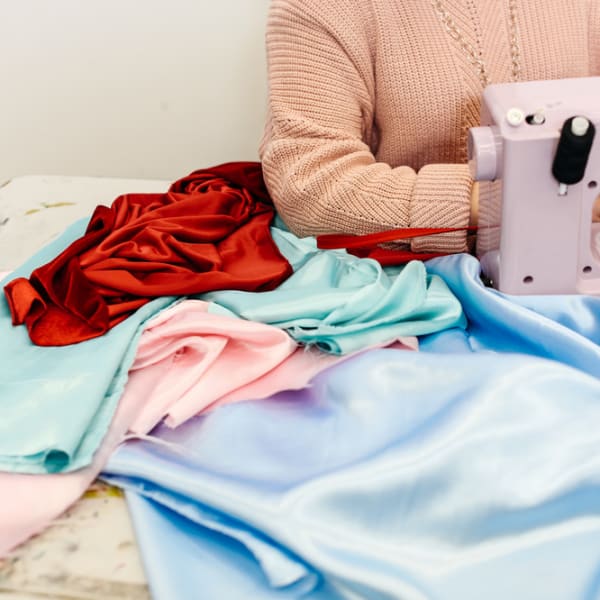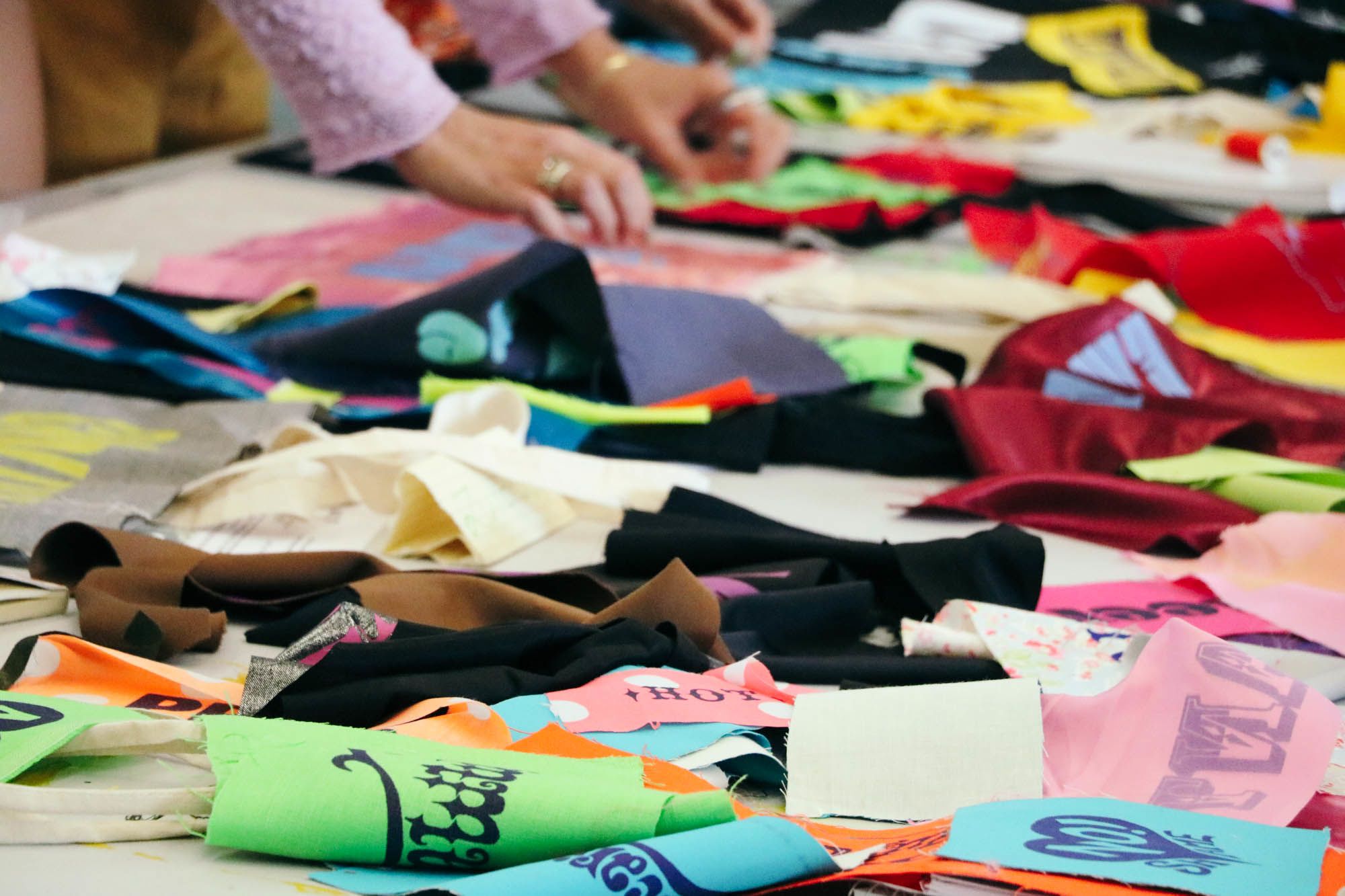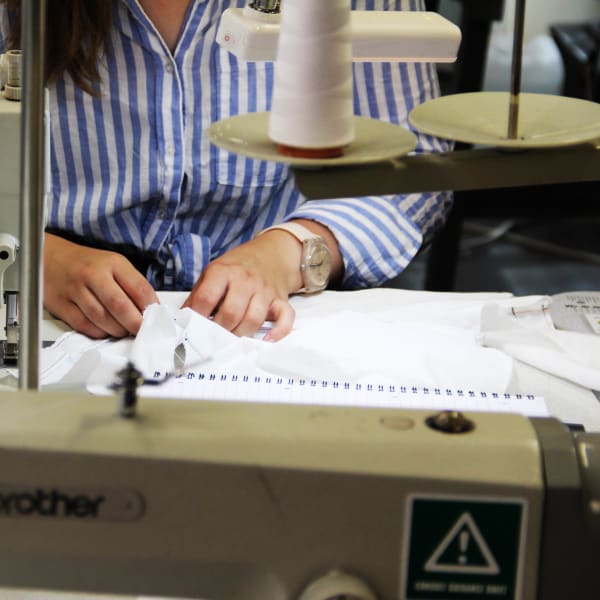
How to start sewing for beginners

- Written byCarys Thomas
- Published date 11 May 2022

Did you know sewing is one of the oldest textile arts? The art of sewing is in fact at least 20,000 years old. Historians believe Stone Age people sewed fur and leather clothing using thread made from animal parts.
One of the earliest sewing machines was designed in 1830 and produced in France by Barthélemy Thimonnier, who received a grant from the French government to mass-produce uniforms for the French army. Many French tailors rioted because they feared that the invention would destroy their businesses.
Sewing is a valuable skill that can transform the way you live, dress and shop. It can be a great way to save money, develop your own personal style and help the environment. Read more about the benefits in our guide on 5 reasons to start sewing.
If you’re looking to take up sewing as a beginner, this guide should help you get started. We’ll explore the benefits of sewing, what you’ll need, some top tips for beginners and the best sewing patterns to try. We’ll also share some useful advice for beginners from fashion lecturer and designer, Christopher Kelly. Christopher has worked as a fashion tutor for a number of prestigious institutions including Liverpool John Moores and Central Saint Martins.
In addition, we'll hear from the winner of the Great British Sewing Bee 2019, Juliet Uzor, to find out more about her short course experience at London College of Fashion and discuss her tips for sewing beginners. Read more about Juliet's experience on the Introduction to Digital Pattern Cutting for Production Short Course.
Getting started
The trick is to start small – begin by taking on small and manageable projects to build your confidence. Starting with a few simple tasks will allow you to develop some basic skills before you progress on to more complex tasks. Try learning how to sew a button or buttonholes before moving on to sewing hems, pleats and pockets.
“My best advice for anyone that wants to begin sewing is to start with something simple,” says Chris, “it’s all about building an understanding of your machine. Pick a project that has lots of repetitive lines or curves, maybe a patchwork project? You want to try and understand the speed and rhythm of the machine. Once you have that covered you can move onto more complex projects.”
Your choice of fabric is also important. Avoid picking any kind of fabric that has a slippery texture to begin with as you may find it difficult to work with. A woven fabric like chambray or cotton canvas would be a good option to start with.
Taking a short course on the subject can help you learn various industry techniques that will enable you to achieve a professional and accurate finish. Our Introduction to Professional Sewing Skills Short Course is a good choice for beginners and will help you become familiar with the basics of machine sewing.
What you'll need
We’ve compiled a list of equipment that should help you on your sewing journey, but remember you can get started with just a few supplies, particularly if you want to try stitching by hand. Basic sewing kits are available to buy from most craft stores and supermarkets, but these tend to work best for simple tasks like making repairs or sewing buttons.
Try to keep hold of any materials you may have around the house, such as old clothes, curtains or sheets, as these fabrics can be useful to practice with and can be used to create new garments.
- Needles - go for a few different types and sizes to use for varied sewing tasks
- Thread - a selection of colours will help you achieve a professional finish
- Sewing scissors - these will be much more effective at cutting fabric than regular scissors so are often worth the investment
- Pins - a pin cushion would also be useful for easy storage
- Measuring tape - an essential
- Pattern weights - you may find these helpful to stop fabric moving around while you’re working on a pattern
- Sewing machine – something that will require an initial expense but will save costs in the long run and is a huge time-saver
- Rotary cutter - this tool is really helpful for cutting out patterns and can slice through multiple layers of fabric. Rotary cutters are available to buy in a variety of blade sizes; popular choices are 18mm, 28mm, 45mm and 60mm.
- Seam ripper - this handy tool is ideal for beginners. If you make a mistake, you can use a seam ripper to unpick the stitching and start over.
Best sewing patterns for beginners
Some good sewing projects for beginners to try include cushion covers, tote bags, purses, scarves, and fabric coasters. There are many sewing patterns available online which can be used as a template and offer a useful reference point for designs. Tote bags can be a great option for beginners to try as the construction is fairly simple and straightforward and involves mostly straight-line sewing. You can also experiment with size and style or print your own designs onto the fabric.
Opt for a lightweight fabric like cotton if you can as this is one of the easiest fabrics to work with and is perfect to learn to sew with. Take a look at these sewing patterns inspired by the V&A collections for some ideas.
Chris recommends learning about different seam types to develop your skills. “Once you have found your feet with your machine, I would suggest expanding your knowledge of construction, which applies to fashion or textile’s construction,” he says. “By construction I mean all the different types of seams that are available to you. Each one has a different purpose and finish. The plain seam will be your starting point but then you can try moving on to the more difficult and French seam. Try to build up a database of all the seams available to you. Then, when you move on to a more challenging project you have this database of seams to draw upon.”
Read on for our top tips for beginners:
1# Experiment
One of the best things about sewing is how easy it is to experiment. Try experimenting with the size and shape of your designs, resize old clothes, change the length, add more fabric or cut a garment down for a new look. Try looking for different fabrics in charity shops and thrift stores - you’ll find that many old clothing items can be given a new lease of life with a few simple fixes or adjustments. Upcycling clothes and accessories can be an enjoyable and rewarding process.
#2 Be well prepared
Good preparation is vital when taking on any kind of sewing project. Planning what you’ll need beforehand, from the type of needle to the choice of material, will save you a lot of time and make the process much more enjoyable. It’s important to choose the right needle for your sewing project, for example. Sewing machine needles come in different sizes and have different tips. A ball-point needle is the best option for stretchy, knit fabrics but won't work so well if used on other types of woven fabric. Using a needle that isn’t suited to your project can undermine the quality of your sewing work and cause rips or tears.
3# Invest
If there’s one thing to invest in (after a sewing machine of course!), it’s a pair of good-quality sewing scissors. It may be tempting to reach for the scissors you use for cutting paper or sticky tape, but these scissors will not be the best option for cutting fabric. You will struggle to achieve a smooth finish with these scissors as it will be difficult to glide across the fabric.
4# Be patient
"My advice would be to practice" says Juliet, "use every mistake as a learning opportunity. If you get frustrated with a particular project, don't give up. Put it away and revisit it with fresh eyes. Also, the unpicker is your friend." It takes time to improve your sewing skills. Don’t be discouraged if you make mistakes or find that projects take a long time to complete. Practice different stitches, watch online tutorials and consider getting hold of a sewing machine to help you tackle more advanced projects.
5# Keep an open mind
Inspiration is everywhere – keep an open mind and be prepared to have a go at anything. Chris has always been inspired by designer and maker Alexander McQueen’s work, “I was lucky enough to do one of my internships at McQueen and work backstage on a few of his fantastical shows,” he says. “One of the most memorable being Voss, 2002. Seeing his garments close up gave me an insight to the sophisticated and complex construction behind his designs.” Since then, Chris has focused on textile sculpture and often produces large scale crochet forms that work independently and on the human body. “My inspirations have evolved and I now look to artists like Nick Cave and Mrinalina Mukherjee,” he tells us.
If you want to improve your sewing skills, our fashion making and pattern cutting short courses may be a good fit for you. Check out our upcoming short courses for more information.
You may also be interested in learning more about textiles through one of our textiles and materials short courses. Our range of textiles courses cover everything from concept to catwalk, including textile design, fabrics and fibres, surface design, textile print and portfolio development.
